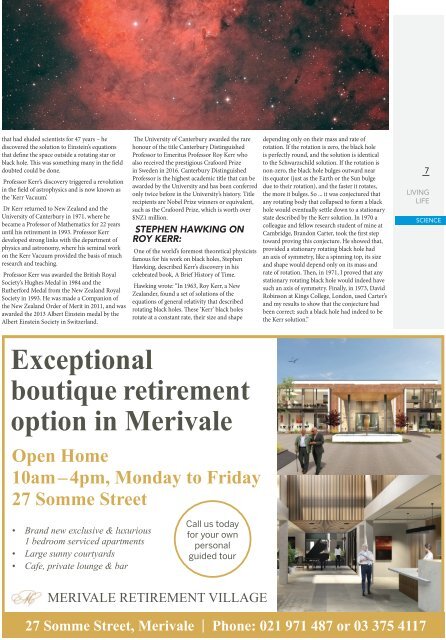Living Life: April 25, 2019
Create successful ePaper yourself
Turn your PDF publications into a flip-book with our unique Google optimized e-Paper software.
that had eluded scientists for 47 years – he<br />
discovered the solution to Einstein’s equations<br />
that define the space outside a rotating star or<br />
black hole. This was something many in the field<br />
doubted could be done.<br />
Professor Kerr’s discovery triggered a revolution<br />
in the field of astrophysics and is now known as<br />
the ‘Kerr Vacuum’.<br />
Dr Kerr returned to New Zealand and the<br />
University of Canterbury in 1971, where he<br />
became a Professor of Mathematics for 22 years<br />
until his retirement in 1993. Professor Kerr<br />
developed strong links with the department of<br />
physics and astronomy, where his seminal work<br />
on the Kerr Vacuum provided the basis of much<br />
research and teaching.<br />
Professor Kerr was awarded the British Royal<br />
Society’s Hughes Medal in 1984 and the<br />
Rutherford Medal from the New Zealand Royal<br />
Society in 1993. He was made a Companion of<br />
the New Zealand Order of Merit in 2011, and was<br />
awarded the 2013 Albert Einstein medal by the<br />
Albert Einstein Society in Switzerland.<br />
The University of Canterbury awarded the rare<br />
honour of the title Canterbury Distinguished<br />
Professor to Emeritus Professor Roy Kerr who<br />
also received the prestigious Crafoord Prize<br />
in Sweden in 2016. Canterbury Distinguished<br />
Professor is the highest academic title that can be<br />
awarded by the University and has been conferred<br />
only twice before in the University’s history. Title<br />
recipients are Nobel Prize winners or equivalent,<br />
such as the Crafoord Prize, which is worth over<br />
$NZ1 million.<br />
STEPHEN HAWKING ON<br />
ROY KERR:<br />
One of the world’s foremost theoretical physicists<br />
famous for his work on black holes, Stephen<br />
Hawking, described Kerr’s discovery in his<br />
celebrated book, A Brief History of Time.<br />
Hawking wrote: “In 1963, Roy Kerr, a New<br />
Zealander, found a set of solutions of the<br />
equations of general relativity that described<br />
rotating black holes. These ‘Kerr’ black holes<br />
rotate at a constant rate, their size and shape<br />
depending only on their mass and rate of<br />
rotation. If the rotation is zero, the black hole<br />
is perfectly round, and the solution is identical<br />
to the Schwarzschild solution. If the rotation is<br />
non-zero, the black hole bulges outward near<br />
its equator (just as the Earth or the Sun bulge<br />
due to their rotation), and the faster it rotates,<br />
the more it bulges. So ... it was conjectured that<br />
any rotating body that collapsed to form a black<br />
hole would eventually settle down to a stationary<br />
state described by the Kerr solution. In 1970 a<br />
colleague and fellow research student of mine at<br />
Cambridge, Brandon Carter, took the first step<br />
toward proving this conjecture. He showed that,<br />
provided a stationary rotating black hole had<br />
an axis of symmetry, like a spinning top, its size<br />
and shape would depend only on its mass and<br />
rate of rotation. Then, in 1971, I proved that any<br />
stationary rotating black hole would indeed have<br />
such an axis of symmetry. Finally, in 1973, David<br />
Robinson at Kings College, London, used Carter’s<br />
and my results to show that the conjecture had<br />
been correct: such a black hole had indeed to be<br />
the Kerr solution.”<br />
7<br />
LIVING<br />
LIFE<br />
SCIENCE<br />
Exceptional<br />
boutique retirement<br />
option in Merivale<br />
Open Home<br />
10am – 4pm, Monday to Friday<br />
27 Somme Street<br />
• Brand new exclusive & luxurious<br />
1 bedroom serviced apartments<br />
• Large sunny courtyards<br />
• Cafe, private lounge & bar<br />
Call us today<br />
for your own<br />
personal<br />
guided tour<br />
MERIVALE RETIREMENT VILLAGE<br />
27 Somme Street, Merivale | Phone: 021 971 487 or 03 375 4117


















